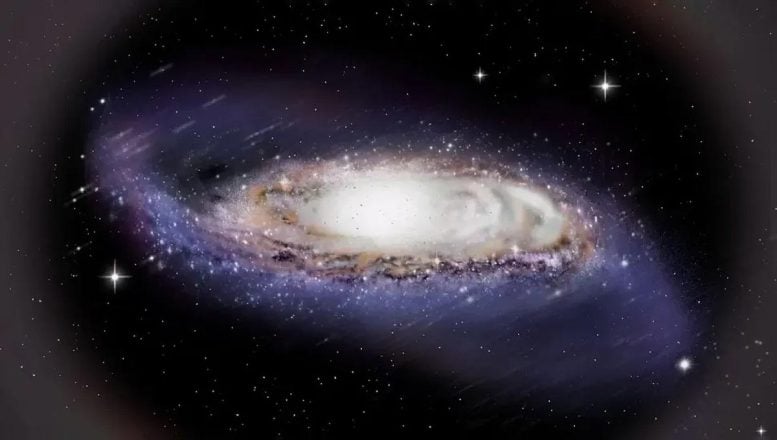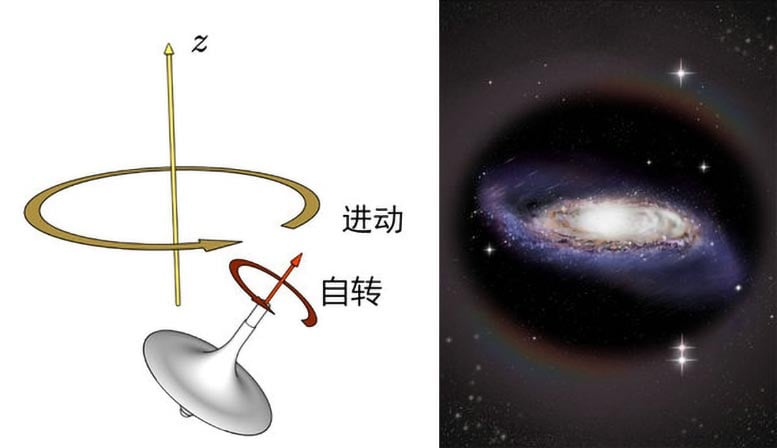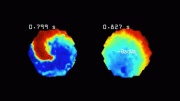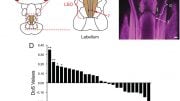
Researchers have measured the Milky Way’s warp precession with Cepheid stars, uncovering an oblate dark matter halo influencing the galaxy’s structural dynamics. Credit: Kaiyuan Hou and Zhanxun Dong from the Shanghai Jiao Tong University
A research team developed a novel “motion picture” method to measure the precession rate of the Milky Way’s warp using Cepheid variable stars. Their findings suggest the Milky Way’s dark matter halo is slightly oblate, shaping our understanding of galactic dynamics and the structure of the universe.
Astrophysicists pioneered a “motion picture” method for measuring the precession rate of the Milky Way’s disk warp. This method allows the clear observation of the precession direction and rate of the Milky Way’s warp using a sample of Cepheid variable stars of different ages. Based on these measurements, the team revealed that the current dark matter halo of the Milky Way is slightly oblate. Led by Dr. Yang Huang from the National Astronomical Observatories of the Chinese Academy of Sciences (NAOC), the research team published their study in Nature Astronomy.
In the nearby universe, nearly one-third of disk galaxies are not perfect disks but exhibit a warped shape resembling a potato chip. Astronomers refer to this phenomenon as a disk warp. The Milky Way, as a typical disk galaxy, also has this warp feature. It is generally believed that the warp originates from the rotational plane of the outer disk stars deviating from the symmetry plane of the surrounding dark matter halo. This tilted, rotating Galactic disk, much like a spinning top, inevitably undergoes precession due to the torque exerted by the surrounding dark matter halo.
Challenges in Measuring Galactic Precession
However, the measurement of this important dynamic parameter, both in direction and rate, has been widely debated. This is because previous measurements relied on indirect kinematic methods, where the tracers used are subject to dynamical perturbations or heating effects, greatly limiting their accuracy and precision.
This study used 2,600 young classical Cepheid variable stars discovered by Gaia as tracers, along with precise distance and age data from both Gaia and LAMOST. The researchers, using the “motion picture” method, constructed the three-dimensional structure of the Milky Way’s disk across populations of various ages but all younger than 250 Myr.

Left panel: the spinning top precesses under the torque from gravity; Right panel: similar to the spinning top, the Galactic disk warp “dances gracefully” under the torque of the dark matter halo. Credit: Kaiyuan Hou and Zhanxun Dong from the Shanghai Jiao Tong University
Findings on Warp Precession and Galactic Dynamics
By “seeing” how the disk warp evolves with age, the researchers found that the warp precesses in a retrograde direction at a rate of 2 km/s/kpc (or 0.12 degrees per million years).
Further measurements showed that the warp’s precession rate gradually decreases with radius. Regardless of the origin of the warp, its precession rate and direction were jointly determined by the Galactic inner disk and the dark matter halo.
Implications for the Milky Way’s Dark Matter Halo
After subtracting the contribution of the Galactic inner disk, the researchers found that the current dark matter halo enveloping the warp exhibits a slightly oblate ellipsoidal shape with a flattening ratio q between 0.84 and 0.96 for the equipotential surfaces. Currently, only this shape can explain the remaining precession rate of the warp.
This study provides a crucial anchor point for studying the evolution of the Milky Way’s dark matter halo.
Reference: “A slightly oblate dark matter halo revealed by a retrograde precessing Galactic disk warp” by Yang Huang, Qikang Feng, Tigran Khachaturyants, Huawei Zhang, Jifeng Liu, Juntai Shen, Timothy C. Beers, Youjun Lu, Song Wang and Haibo Yuan, 27 June 2024, Nature Astronomy.
DOI: 10.1038/s41550-024-02309-5









Be the first to comment on "Revealing the Milky Way’s Warp: How Cepheid Stars Map Our Dark Matter Halo"